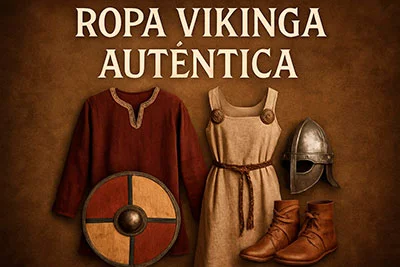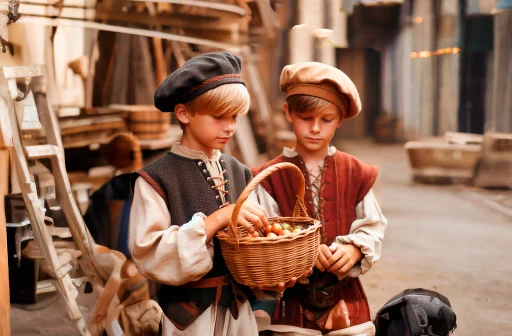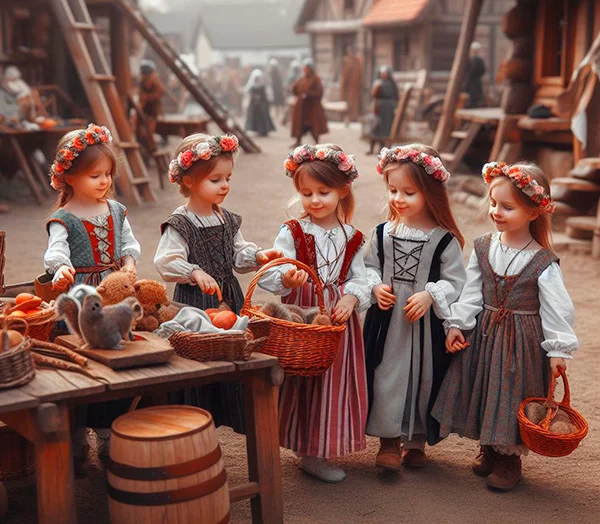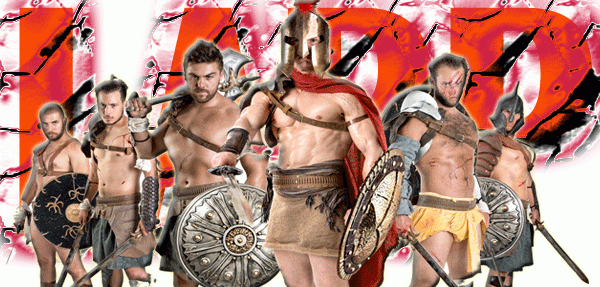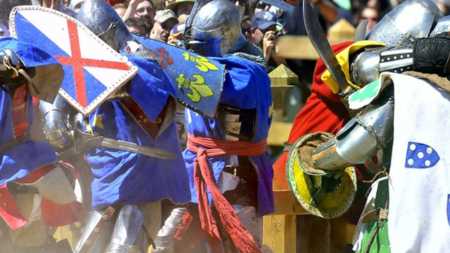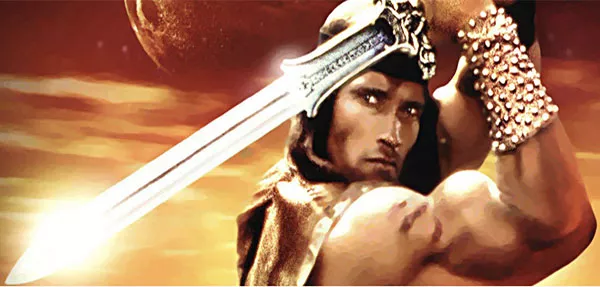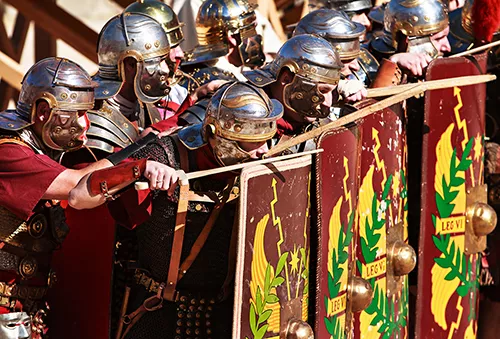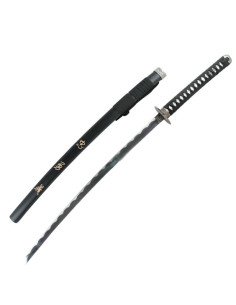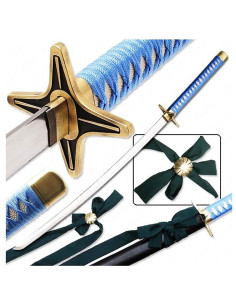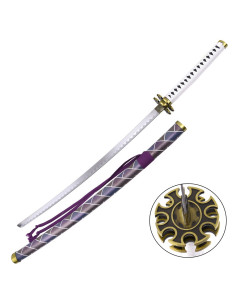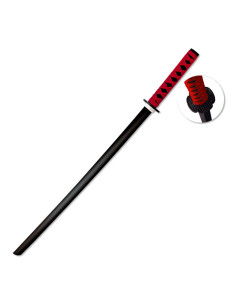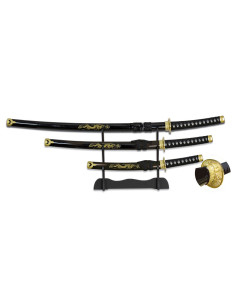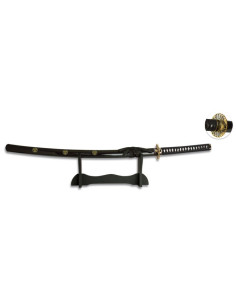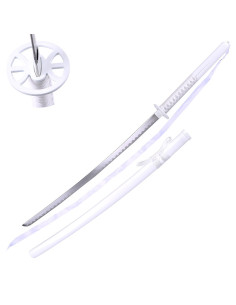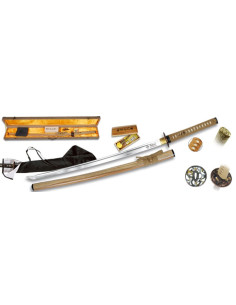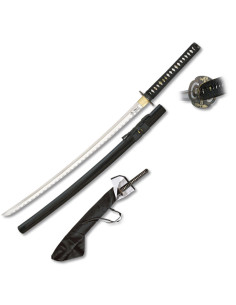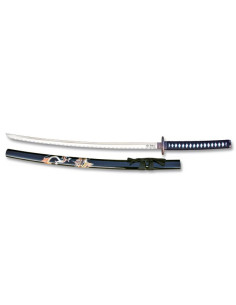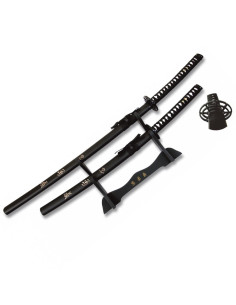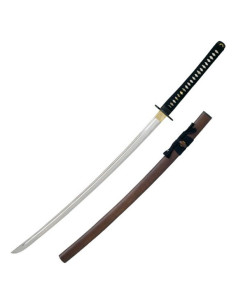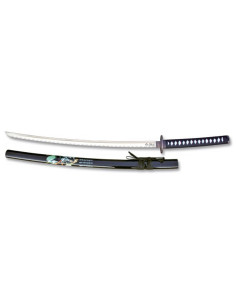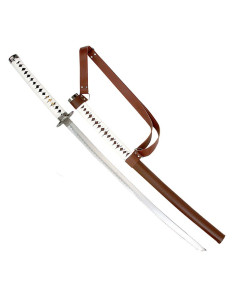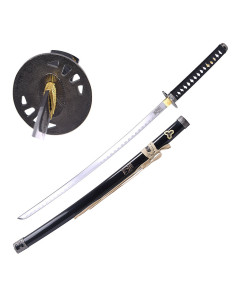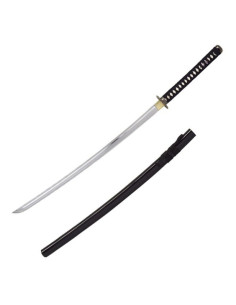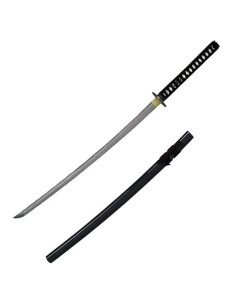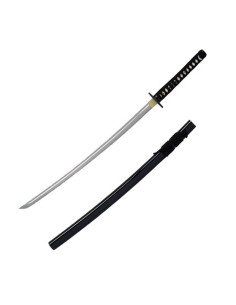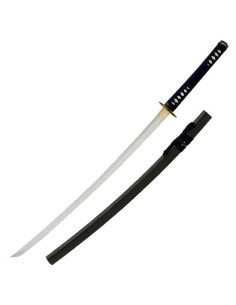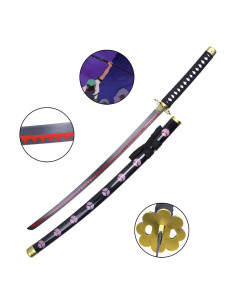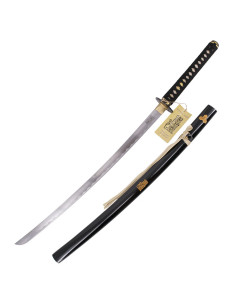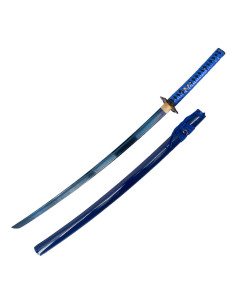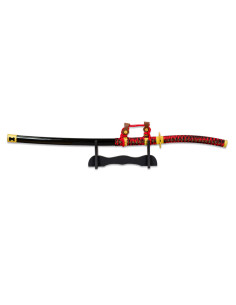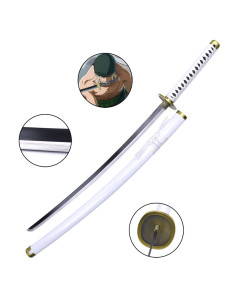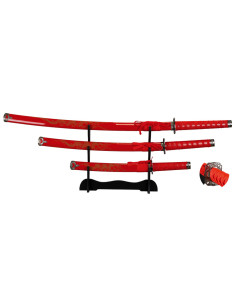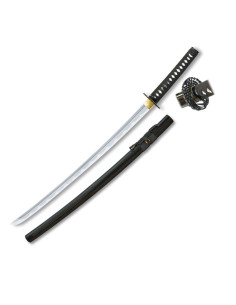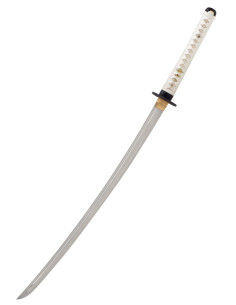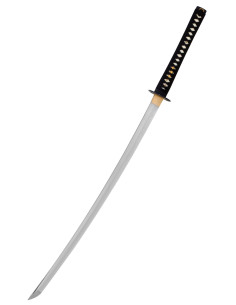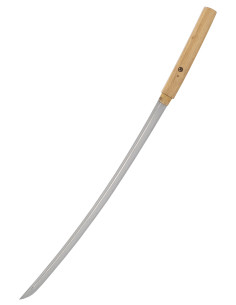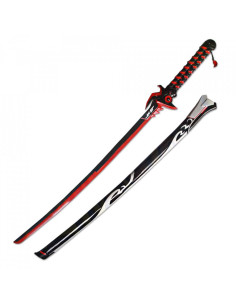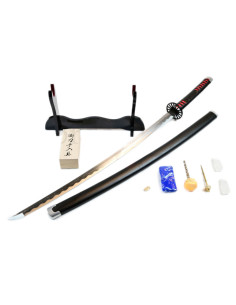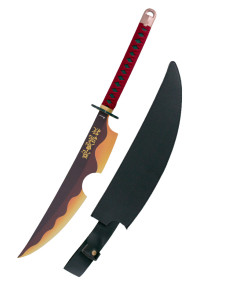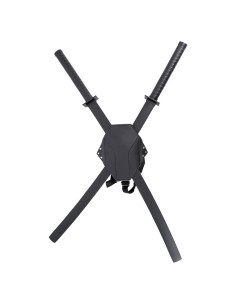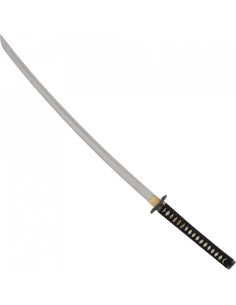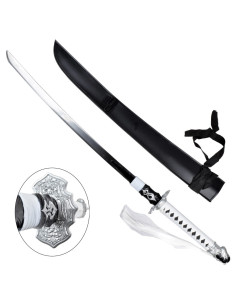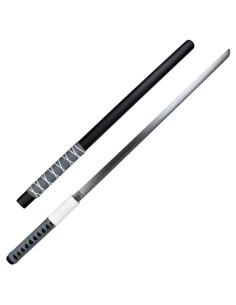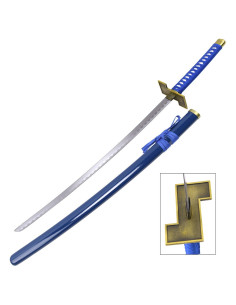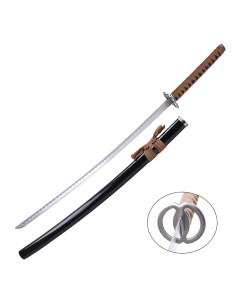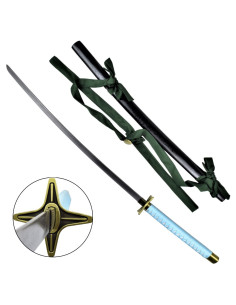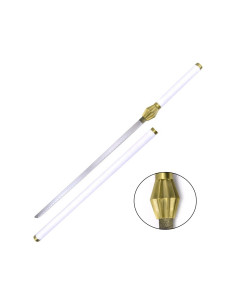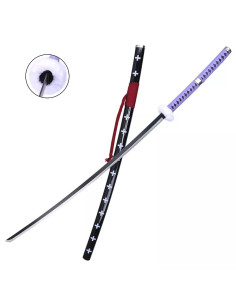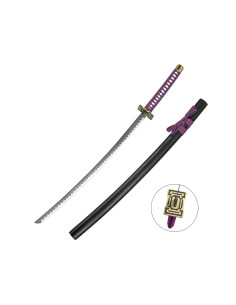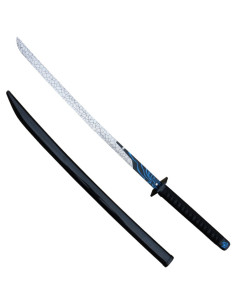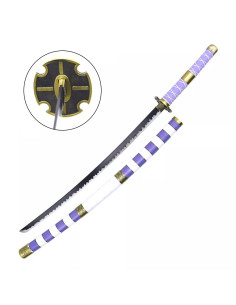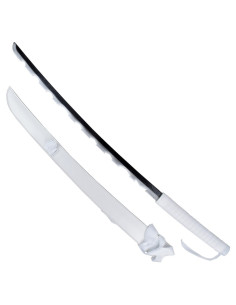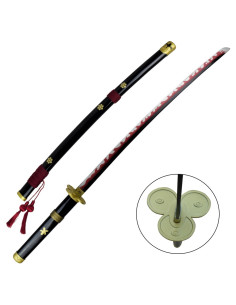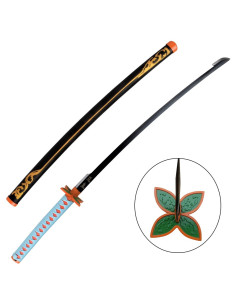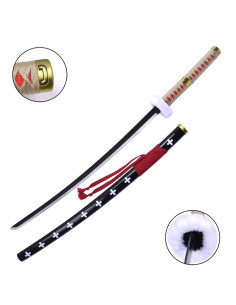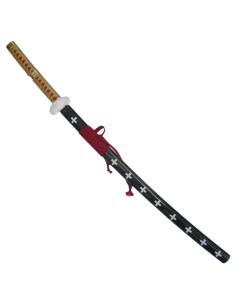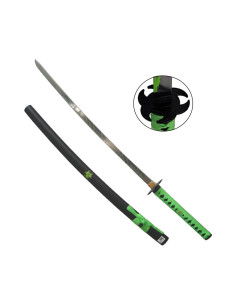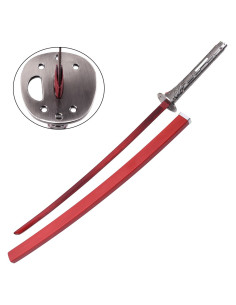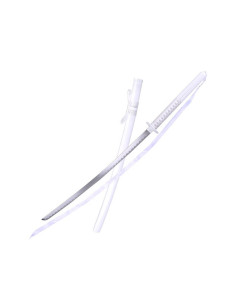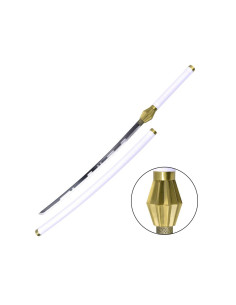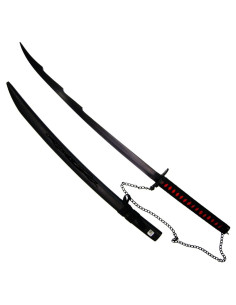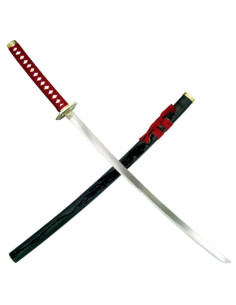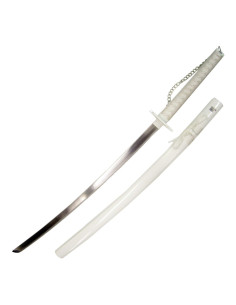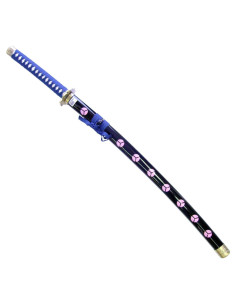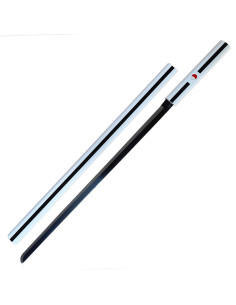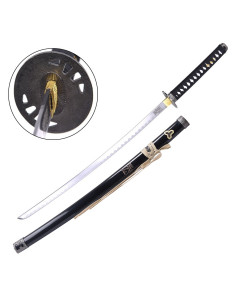Katana
Katana, Wakizashi and Tanto red with black lacquer stand
Decorative Katana wakizashi in September and with stand
Samurai Decorative Katana with Black Sheath and Stand - Tole10 Imperial
Jetstream Sam's Katana from Metal Gear Rising: Revengeance (113 cm.)
Katana Tensa Zangetsu Evolution, heaven chain slaying moon, Ichigo Kurosaki (101 cm.)
Tradition and Craftsmanship: Authentic and Traditional Japanese Katanas
The history and technique behind Katanas are a living heritage: from tempered steel to the final polish, each piece reflects centuries of tradition. In our collection, you will find examples that honor this lineage, such as the hand-forged Katana of Rengoku Kyoujurou and the Golden Lion Damascus Steel Katana (104.8 cm), each crafted to offer a balance between beauty and durability. The phrase "authentic and traditional Japanese Katanas" is not just a slogan; it is a quality promise encompassing forging methods, material selection, and finishing, designed both for collectors and those seeking a piece with authorship and historical reference.
Beyond the aesthetic aspect, the forging determines performance in combat and preservation. Models like the Iaito John Lee Zaza model Katana and the 1060 steel Ghost of Tsushima-type katanas offer different handling sensations, resulting from heat treatment and material composition. If you are looking for a functional Katana or a display piece, knowing the origin of the steel, whether it was hand-forged, and the type of blade will help you choose wisely. Our catalog includes everything from inspired replicas to utility katanas for controlled training.
Functional Katanas and Practical Use
For those who want a Katana suitable for cutting or controlled practice, we select models designed for responsible use. Among them stand out the functional Kamado Tanjirou Katana from Demon Slayer and the functional unofficial Sekiro video game Katana (103 cm), which combine hardened blades with mounts designed for safety and durability. We also offer options like the Sharpened John Lee Ninjato Sword, recommended for those seeking an effective edge with consistent craftsmanship. Before purchasing, evaluate whether the sword meets safety standards and the intended purpose of the piece: display, cutting, or light training.
Additionally, Katanas for recreation or LARP, such as the Ryugan LARP Katana Noble model, are made with resistance to continuous handling and stage aesthetics in mind. Sets that include wakizashi and tanto, like the Punisher katana, wakizashi, and tanto set with stand, offer complete solutions for traditional training or display. Remember that a functional Katana requires periodic maintenance, sharpening, and a proper sheath or stand to preserve its integrity and safety.
Design and Collectible Pieces: Ornamental and Thematic Katanas
The aesthetic diversity in Katanas allows for finding everything from sober pieces to katanas with engravings and striking finishes. In our offer, there are models like the ornamental Katana with engraved blade (112 cm), the Tole10 Dragon Katana, and the ornamental set with floral red-black katana, wakizashi, and tanto that combine art and presentation. We also have iconic replicas such as Sasuke Uchiha’s white Katana from Naruto (99 cm) or Okina’s Katana from Rivers of Blood, designed for fans who value visual fidelity and details faithful to the original.
For collectors, materials, the saya’s enamel, and the quality of the tsuba are determining factors. Some decorative or display pieces incorporate steels like Damascus or silver and gold finishes that enhance their aesthetic value, while sets with desktop stands — such as the Set of 3 Red Dragon Katanas with desktop stand — facilitate safe exhibition. Selecting a Katana intended for collection involves considering origin, maker’s signature, and coherence between design and finish.
Katanas Inspired by Anime, Manga, and Video Games
Popular culture has boosted interest in Katanas through memorable characters. Our category pays tribute to these creations with high-fidelity replicas: Kanao Tsuyuri’s Katana from Kimetsu No Yaiba (98 cm), Shinobu Kocho’s bamboo Katana from Kimetsu No Yaiba (97 cm), Obanai Iguro’s silver-finished Demon Slayer Katana, and the hand-forged Yamato Katana of Vergil from Devil May Cry 3. Additionally, shonen figures like Bleach’s Zangetsu Shikai Sword or Ichigo Kurosaki’s Tensa Zangetsu Katana are available for fans who want an iconic piece with details faithful to the original.
Video game fans also find carefully crafted references: Sekiro: Shadows Die Twice’s earth Katana (98 cm) and the functional Katana inspired by Sekiro offer aesthetics and stage presence. For those who value themed sets, the Tokitou Muichirou Demon Slayer banner + katana pack or the Mini Rengoku Kyojuro Katana from Demon Slayer are ideal as collectible pieces or gifts. These replicas combine design, proportion, and finishes tailored to the audience of each narrative universe.
How to Choose Your Katana: Buying and Maintenance Tips
Choosing the right Katana depends on several factors: intended use (display, cutting, LARP), length (for example, Nodachi or standard katanas around 100 cm), blade material, and type of mount. If you want a functional Katana, consider tempered and welded blades, as well as handles with good grip. For collectors, the saya’s aesthetics and engraving quality can be decisive. Models like the Katana with sheath or the Decorative Samurai Katana with Black Sheath and Stand - Tole10 Imperial exemplify ready-to-show and preserve options.
Maintenance is essential: regular cleaning, protective oil, and storage in dry environments extend lifespan. Avoid unnecessary impacts and use proper stands; sets with stands, like the Set of 3 Red Dragon Katanas with desktop stand, facilitate safe display. If you buy a sharpened or functional Katana, learn about safety techniques and local regulations. With the right choice and proper care, a Katana can be both a piece of history and a personal legacy.
How to differentiate a functional Katana from a display one?
A functional Katana is usually made with heat-treated steel to maintain the edge and absorb impacts; moreover, its mount is robust and designed for continuous use. Display ones prioritize aesthetic finish, may use softer steels or ornamental concepts, and do not always withstand repeated cutting. Checking the type of steel, tempering, and whether the blade is sharpened or just polished helps identify its purpose.
What basic care does a Katana need to prevent corrosion?Rust prevention includes cleaning the blade with a soft cloth after handling, applying a thin layer of protective oil, and storing the Katana in a dry environment. Avoid contact of the blade with moisture or wet materials and use a sheath or stand that does not retain water. For functional katanas, periodically check the edge and disassemble the handle if necessary to clean internal areas where dirt accumulates.
Is it legal to own a Katana in Spain and what precautions should I take?In many countries, including jurisdictions in Spain, owning Katanas is legal for collecting as long as they are not used for illicit purposes; however, it is important to be informed about local regulations and transportation. Keep your Katana securely at home, avoid displaying it in public without proper measures, and ensure compliance with laws on bladed weapons at events or during transport. If in doubt, consult municipal or regional regulations.
What are the differences between a hand-forged Katana and a mass-produced one?A hand-forged Katana usually involves greater artisanal intervention, polishing, and personalized treatments that can enhance features like the hamon, flexibility, and aesthetic quality. Mass-produced ones offer uniformity and more competitive prices but may sacrifice unique details and certain artisanal processes. For collectors, a hand-forged piece adds historical value and uniqueness; for practical use, steel quality and tempering are key factors beyond the production method.
What type of Katana is most suitable for historical training or Iaido?For Iaido and controlled practices, katanas with good balance and not excessively sharp blades are recommended if repeated kata are to be performed safely. Iaito and replicas specific for training usually offer a good balance between weight and safety. For kumitachi or real cutting, look for functional katanas with tempered blades and certified cutting tests. Evaluating the instructor and dojo regulations helps decide the appropriate model.
How to choose the correct length of a Katana?The ideal length depends on the user’s build and intended use. About 100 cm is standard for adults, but those practicing specific techniques or seeking historical authenticity may opt for longer measures or nodachi. Consider your usage distance, height, and style practiced; if in doubt, check product descriptions specifying measurements like 98 cm, 99 cm, or 104.8 cm to compare with your comfort handling it.
What accessories are recommended when buying a Katana?Stands and cases protect and display the Katana, while oils, cloths, and cleaning kits keep the blade in good condition. A desktop stand or vertical support prevents deformation of the saya and facilitates presentation. For collections, cases or vitrines with humidity control provide long-term preservation; if your piece is functional, also consider a quality tsuba and appropriate protectors for safe transport.
Discover our selection of authentic and stylized Katanas: from anime replicas to hand-forged pieces. Explore functional models, sets, and collectibles to add the perfect sword to your collection or practice. Safe shopping and updated catalog today.

